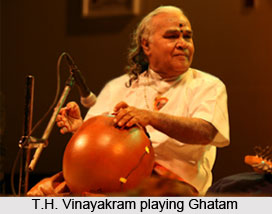 Ghatam is a large, narrow-mouthed earthenware water pot used as a percussion instrument in Indian music. It is especially used in conjunction with the Mridangam in the Carnatic music of South India. Ghatam produce a distinctive metallic sound and are made in several sizes, each size having a different pitch. It is played with the hands and fingers and can produce a large variety of sounds right from the neck to the body of the ghatam. The ghatam is one of the most ancient percussion instruments of South India.
Ghatam is a large, narrow-mouthed earthenware water pot used as a percussion instrument in Indian music. It is especially used in conjunction with the Mridangam in the Carnatic music of South India. Ghatam produce a distinctive metallic sound and are made in several sizes, each size having a different pitch. It is played with the hands and fingers and can produce a large variety of sounds right from the neck to the body of the ghatam. The ghatam is one of the most ancient percussion instruments of South India.
Etymology of Ghatam
Ghatam replicates or conveys the meaning of the pot in Sanskrit. Ghatam is known as “Noot†in Kashmir, “Mudki†in Rajasthan and in Punjab it is called “Badaâ€.
Significance of Ghatam in Indian Music
Ghatam was a folk instrument in olden days. In south India, Ghatam is a highly sophisticated instrument raised to concerts status. Apart from traditional concert platforms, Ghatam is also gaining prominent status in Rock music, Jazz, Jugal bandhis, Fusion, Ensembles and unique programmes. The Ghatam produces fast rhythmic patterns and is generally a secondary percussion instrument accompanying Mridangam in the form of Sawal-Jawab (question-answer play).
Process of Making a Ghatam
Ghatam is made mainly of clay which is baked with brass or copper filings mixed with a small amount of iron filings. Although the ghatam is the same shape as an ordinary Indian domestic clay pot, it is made specifically to be played as an instrument. The tone of the pot must be good and the walls should be of even thickness to produce an even tone. This type of ghatam is harder to play but produces a sharp metallic ringing sound which is favoured by some players. Ghatams are mostly manufactured in Manamadurai, a place near Madurai in Tamil Nadu.
 Types of Ghatam
Types of Ghatam
Ghatams are of two types: Madras and Manamadurai. The Madras Ghatam is a light pot which requires less force to play while the Manamadurai Ghatam is a heavy pot, which is difficult to play, and produces a sharp metallic ringing sound. These ghatams have special tonal quality and is believed that the mud is of special quality.
Playing of a Ghatam
Ghatam is played in two different ways. In North India, the instrument is placed on a small round block with the mouth facing upwards and played on the sides by right hand on the mouth by left hand. Rings and bangles are also used to create sound. But in South India, it is placed on the lap, its mouth facing the stomach, played with gush of air with the help of belly. It is played with fingers, wrists and even nails. Hitting different areas of the pot with different hands can produce different tones. Its position is changed while playing. It is the only instrument whose position is changed while playing. Sometimes to delight the audience, the instrument is thrown up and caught suitable in rhythm.
Popular Musicians of Ghatam
The Great Maestro of Ghatam, Padmashri T.H. Vinayakram also known as "Vikku", Ghatam Giridhar Udupa and K. Venkataram are the oldest and most respected players in India. It is believed that the famous Kanjira player Pudukkotai Dakshina Murthy Pillai was well versed in ghatam also. Later Palani Krishna Iyer, Sundaram Iyer, Vilvadri Iyer, Alangudi Ramachandran, Kothandarama Iyer were all notable ghatam Maestros. Sukanya Ramagopal is first and leading lady Ghatam Artist in India. She has been playing the instrument since 30 years and mastered it.